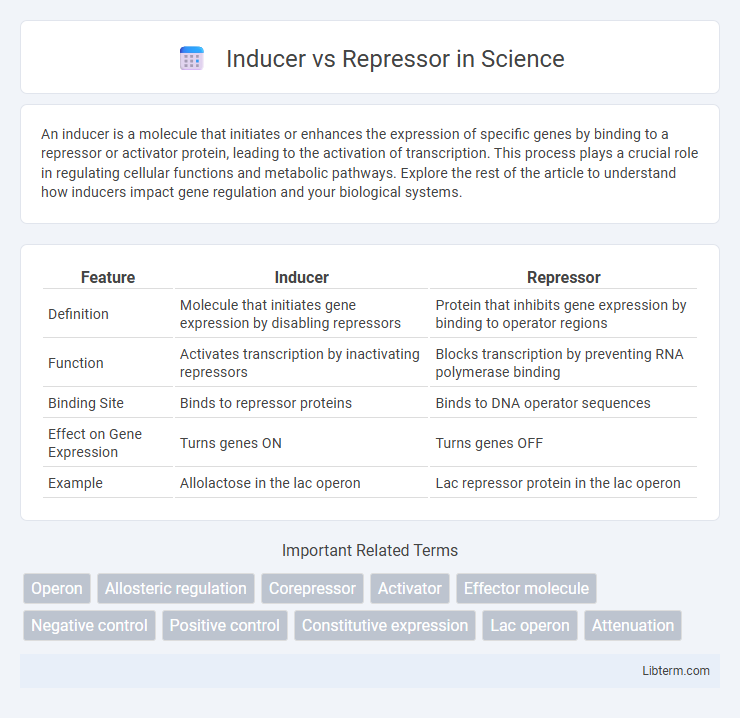An inducer is a molecule that initiates or enhances the expression of specific genes by binding to a repressor or activator protein, leading to the activation of transcription. This process plays a crucial role in regulating cellular functions and metabolic pathways. Explore the rest of the article to understand how inducers impact gene regulation and your biological systems.
Table of Comparison
| Feature | Inducer | Repressor |
|---|---|---|
| Definition | Molecule that initiates gene expression by disabling repressors | Protein that inhibits gene expression by binding to operator regions |
| Function | Activates transcription by inactivating repressors | Blocks transcription by preventing RNA polymerase binding |
| Binding Site | Binds to repressor proteins | Binds to DNA operator sequences |
| Effect on Gene Expression | Turns genes ON | Turns genes OFF |
| Example | Allolactose in the lac operon | Lac repressor protein in the lac operon |
Introduction to Inducers and Repressors
Inducers and repressors are key regulatory molecules in gene expression that modulate the activity of operons in prokaryotes. Inducers bind to repressors or activator proteins, altering their ability to control transcription, often resulting in the activation of gene expression. Repressors typically bind to operator regions in DNA to inhibit transcription, preventing the production of specific proteins until the presence of an inducer removes this inhibition.
Definition of Inducer
An inducer is a specific molecule that binds to a repressor protein, leading to a conformational change that reduces the repressor's ability to bind to the operator region of a gene, thereby activating gene expression. Inducers often function by preventing the repressor from obstructing RNA polymerase access to the promoter, allowing transcription to proceed. Common examples of inducers include allolactose in the lac operon, which triggers the expression of genes involved in lactose metabolism.
Definition of Repressor
A repressor is a protein that binds to specific DNA sequences, known as operators, to inhibit the transcription of target genes by blocking RNA polymerase access. Repressors play a critical role in gene regulation by preventing the expression of genes in response to environmental or cellular signals. This negative regulation mechanism contrasts with inducers, which activate gene expression by disabling the repressor or enhancing RNA polymerase binding.
Mechanism of Inducer Action
Inducers activate gene expression by binding to repressor proteins, altering their conformation and preventing them from attaching to operator regions on DNA. This inhibition of repressor binding permits RNA polymerase to access the promoter, initiating transcription of the target gene. Common examples include allolactose in the lac operon, which derepresses the lac repressor to enable lactose metabolism.
Mechanism of Repressor Action
Repressor proteins inhibit gene expression by binding to specific DNA sequences called operators, blocking RNA polymerase access and preventing transcription initiation. This mechanism is often modulated by corepressors or inducers that alter the repressor's conformation, either enhancing or inhibiting its DNA-binding ability. The Lac operon exemplifies this process where the lac repressor binds to the operator in the absence of lactose, halting expression of genes required for lactose metabolism.
Key Differences Between Inducer and Repressor
Inducers activate gene expression by binding to repressors or activator proteins, causing the repressor to detach from the operator region of DNA, thereby allowing transcription to proceed. In contrast, repressors inhibit gene expression by attaching to the operator sequence on the DNA, blocking RNA polymerase from transcribing the target gene. The primary key difference lies in their function: inducers facilitate transcription initiation while repressors serve as molecular brakes that prevent it.
Roles in Gene Regulation
Inducers and repressors play crucial roles in gene regulation by modulating the activity of specific genes. Inducers activate gene expression by binding to repressors or activator proteins, causing conformational changes that enable transcription. Repressors inhibit gene expression by binding to operator regions of DNA, preventing RNA polymerase from transcribing the target gene.
Examples of Inducers in Biological Systems
Inducers in biological systems include allolactose, which activates the lac operon by binding to the repressor and preventing it from inhibiting gene expression. Another example is arabinose, which functions as an inducer by interacting with the AraC protein to promote transcription of arabinose metabolism genes. These molecules play crucial roles in regulating gene expression by altering repressor activity and enabling the cell to respond to environmental changes.
Examples of Repressors in Biological Systems
Repressors in biological systems include the LacI protein in E. coli, which inhibits the lac operon by binding to the operator site and preventing transcription in the absence of lactose. Another example is the Trp repressor, which regulates the tryptophan operon by binding to the operator sequence when tryptophan levels are high, thus blocking gene expression. The LexA repressor plays a crucial role in the SOS response by repressing DNA repair genes until DNA damage triggers its self-cleavage, allowing transcription to proceed.
Importance in Biotechnology and Medicine
Inducers and repressors play crucial roles in biotechnology and medicine by regulating gene expression, enabling precise control over protein production in microbial systems. Inducers activate specific genes to produce proteins or enzymes necessary for drug synthesis and metabolic engineering, while repressors inhibit gene expression to prevent unwanted protein formation, enhancing therapeutic efficacy and safety. Understanding their mechanisms allows for the development of engineered gene circuits in synthetic biology, improving targeted therapies and biopharmaceutical manufacturing.
Inducer Infographic

 libterm.com
libterm.com